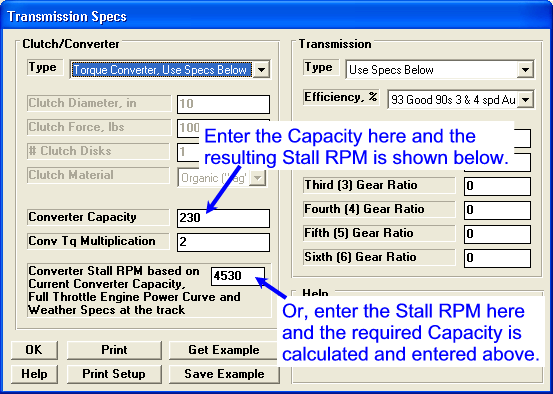Most drag racers running automatics talk about their torque converter’s “stall RPM”. They say things like “I’ve got a 5500 RPM stall converter” or “My converter stalls at 6700 RPM”. Then they are somewhat surprised that when they go to a significantly higher elevation the stall RPM drops. Or someone with the exact same converter behind a much smaller engine stalls at a much lower RPM. Why would the stall RPM change?
First, a little background: Stall RPM is the engine RPM with the engine at full power but with the converter output RPM (also vehicle speed) at zero or “stall”. This is the RPM you see on your tach when you first launch the car at full power. Pick the right converter and you will stall (launch) the car at an optimum engine RPM for quickest ET.
The common misconception is that a converter has a particular stall RPM built in. You buy a 5000 RPM converter and it should stall at 5000 RPM, right?
Think about your everyday 6 cylinder “grocery getter” with an automatic. From a standing start,if you give the engine a little gas, say 1/4 throttle, the engine revs up some (maybe to 1000 RPM) and the car moves. Give it 1/2 throttle and the engine revs higher and you accelerate a little harder. Go full 100% throttle and the engine revs higher to the afore mentioned “stall RPM” and accelerates as hard as this engine/converter combo will allow. For your “grocery getter”, this may be 1800 RPM.
But think, for the 3 situations, all 3 were at the stall RPM for the amount of engine torque you were producing. For a small 2 cylinder engine at full throttle, it may be only be able to produce the torque that your 6 cylinder produced at 1/4 throttle. With the exact same converter, the stall RPM is only 1000 RPM for that 2 cylinder engine. On the other end of the scale, if you replaced your 6 cylinder with a 500 CID V-8, this same converter could stall at 3200 RPM.
The point being a converter does NOT have a stall RPM built in. The stall RPM depends on the engine’s torque curve in front of the converter. If something increases the torque, the stall RPM increases.
What a converter DOES have built in is something called “capacity”, sometimes called “K factor”. The automakers measure the capacity with 2 large dynamometers, one driving the input and the other absorbing the output. They measure torque and RPM in and out, and calculate speed ratio, torque multiplication, efficiency, capacity and more from stall (0 output RPM) to the point ehere the converter locks up (at a speed ratio from 90-98% or so). This requires an expensive test rig and most aftermarket converter suppliers can not afford this. Therefore you typically don’t get a capacity number or performance curves for racing converters. It would be great if you could.
It would be especially great to have these performance curves when it comes to doing a drag race simulation, like done with our Drag Race Analyzer. Because these performance curves are not available (including even the simplest real converter specs like capacity and torque multiplication at stall), we must estimate these critical specs from info the user has. And, typically the user only has some estimate of Stall RPM from the converter supplier. Or, they know their own converter’s stall RPM with their engine from experience at the track.
The Drag Race Analyzer asks for Torque Converter Capacity as an input, but has a method to estimate the capacity from the torque curve you have entered into the program, and the converter’s stall RPM. Capacities range from 80 for a very tight converter up to 400 or higher for very high stall (loose) converters. You can enter the stall RPM, and the program shows the required converter capacity to produce that stall at the current weather conditions with the current torque curve.

The disadvantage of this method is the average user may not understand why they can not just enter the converter’s stall RPM directly. The advantage of this method is that when you go to a different condition, like weather or engine modification, the program will accurately predict the new stall RPM and the new launch, ET and MPH.
For example, say you have a typical big block with a “5000 RPM stall converter”. The Drag Race Analyzer will show the following stall RPMs for the 3 different “air” conditions. These conditions were simulated by changing the elevation from 0 to 1000 to 5000 ft.
Elevation Stall RPM
0 ft 5090
1000 ft 4980
5000 ft 4530
The table shows a 450 RPM drop in stall RPM for a 1 mile increase in elevation. Anyone who has raced at tracks with very different elevations will say the converter stall RPM does drop when the elevation goes up. Now, even if it is harder to understand, wouldn’t you want your drag race simulation program to do the calculations accurately?
Click on blue “Stall RPM” link for FAQ with more info on Stall RPM.